I had the privilege of spending Halloween in Morelia Mexico while on a photo workshop. The celebration of Dia De Los Muertos is a passionate tradition in Mexico which is a three day celebration of their loved ones. Families gather in the graveyard well in advance of “All Hallows Eve,” to prepare the grave for the return of their loved ones. Everyone pitches in and tidies the grave for momentous event. The process involves using the Marigold which hails from Aztec times as the pavers of the golden highway of loved ones to return to earth to join the family and then return trip on All Souls day, November 1st.
Trick or Treat
The people of Mexico relish this holiday. They bring gifts of flowers and food to the grave site to celebrate their loved one who have gone before them. Contrary to the American fear of graveyards and ghosts, these people of passion spend the entire evening in the graveyard, having conversations with their deceased. It is common to sing and dance and play music in the cemetery. People are joyous, not solemn, as they believe that they will be joined with family soon on All Hallows Eve. Quite a different experience that the traditions that we celebrate in the United States.
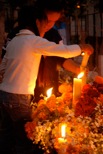
Sugar skulls are the ” piece de resistance” The Mexican people spend hours creating this work of art. They are coveted collectors items and are fashioned from real sugar.
The origin of Mexican sugar skulls is tied to the history of sugar in Mexico, so let’s start at the beginning:
Sugar was first introduced to the Americas before “Mexico” even existed as a country. After the Spanish colonizers arrived in 1521, they quickly discovered that the conditions in the “New World” were perfect for growing sugar on a mass scale. So beginning in the early 16th century, they set up large sugar plantations and imported African slaves (millions over the course of nearly 4 centuries) to perform all the hard labor required to grow sugar. It’s a sad start to the history of sugar skulls, but when considering the origin of Mexican sugar skulls, it’s important to note that sugar is not actually native to Mexico at all.
The making of sugar figures is actually a European tradition as well, and can be traced back to Palermo, Italy, where figurines were made out of sugar as religious decorations. As Spanish Catholic beliefs began to mix with native Mesoamerican beliefs, the Mexicans started making sugar skulls as part of their Dia de los Muertos festivities, dating at least as far back as the mid-18th century; some say the 17th century. By the mid-19th century, it was common for skulls to bear the name of the recipient across the forehead. Mexicans didn’t have much money, but they did have a lot of sugar! This is probably why sugar skulls became so popular over the centuries.
As the years roll on, sugar skull designs have become ever more colorful, creative, and extravagant. Although skilled artisans compete for prizes in the annual Feria del Alfeñique (as described below), many sugar skulls are now mass-produced, causing some to worry that the making of sugar skulls is a dying art form.
My experience was far beyond the skulls, though they are an integral part of the ceremonious activities. While in the graveyard making images from late in the afternoon to well past midnight, my personal experience was humbling. Feeling like a “gringo” which I am, I was overwhelmed by the invitations I received by families to enter their private space and share their memories. I was taken back at the Gringo with the flash and big lens, that the people of this village were so inviting. It brought me to my knees that these people have such intense respect for the dead and are not threatened to share their experience with me.
It was truly a night of celebration. Beyond the graveyard there was music and dancing that closely resemebeld an art fair as we know them here in the states. The making of Tortillas, traditional dancing in the streets and a full bar were a compete opposite of the graveyard events. In addition to the festivities down the street, lawn bowling in the Aztec fashion was underway. This involves an old Mayan tradition of tossing balls on the lawn that were lit with fire inside. Apparently this was a tradition of the Aztecs and Maya. What a sight to behold! So the party starts on the other end of town. I was ushered up to the front by unknown friends to be in order to capture the essence of the dancers. Carrying a Nikon camera really does have impact.
At the end of this remarkable evening my last glance was this one… Need I say anything else?
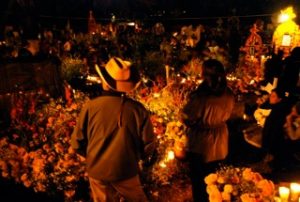
On the bus back to San Miguel de Allende, I reflected on the true meaning of ” All Hallows Eve” and decided that this was a moment for the soul to reflect m own family, that I shall carry with me for years to come. Snickers anyone? Maybe sugar skulls.


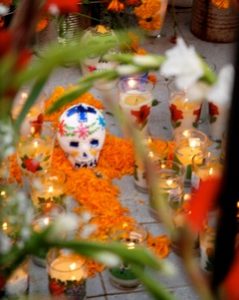
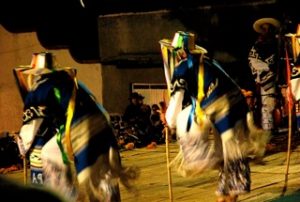
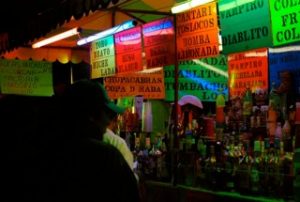

Karol, this is such a loving glimpse into a tradition I knew nothing about. If our Halloween derived from this you can see some of the similarities; (pumpkin) heads, candy, the focus on kids. But we’ve certainly lost its reverence. Thanks for the lovely photos.
Wow, how utterly cool. I love being reminded of Halloween’s spiritual origins.
Thank you Karol for sharing this story. How wonderful that you were conscious of the privilege of being included in this ceremonial evening, and chose to learn the origins of the traditions. Halloween today is fun for the kids, but a pale, commercialized shadow of those significant origins.
I can only echo others’ sentiments: Thank you for the glimpse into a tradition that is both more reverent and more joyous than our own! With our culture’s fear and avoidance of death, we could sure use some of the familiarity and communion that you describe.
Remarkable, your experience seems like a gateway to profound meditation and realization, the story radiates energy.